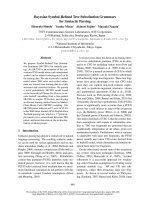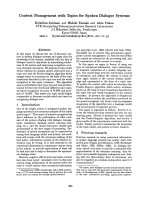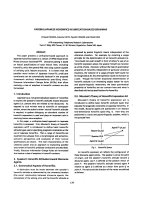Báo cáo khoa học: "Parsing preferences with Lexicalized Tree Adjoining Grammars : exploiting the derivation tree" pptx
Bạn đang xem bản rút gọn của tài liệu. Xem và tải ngay bản đầy đủ của tài liệu tại đây (446.78 KB, 6 trang )
Parsing preferences with Lexicalized Tree Adjoining Grammars :
exploiting the derivation tree
Alexandra KINYON
TALANA
Universite Paris 7, case 7003,
2pl Jussieu 75005 Paris France
Abstract
Since Kimball (73) parsing preference
principles such as "Right association"
(RA) and "Minimal attachment" (MA) are
often formulated with respect to
constituent trees. We present 3 preference
principles based on "derivation trees"
within the framework of LTAGs. We
argue they remedy some shortcomings of
the former approaches and account for
widely accepted heuristics (e.g.
argument/modifier, idioms ).
Introduction
The inherent characteristics of LTAGs (i.e.
lexicalization, adjunction, an extended domain of
locality and "mildly-context sensitive" power)
makes it attractive to Natural Language
Processing : LTAGs are parsable in polynomial
time and allow an elegant and
psycholinguistically plausible representation of
natural language 1. Large coverage grammars
were developed for English (Xtag group (95))
and French (Abeille (91)). Unfortunately, "large"
grammars yield high ambiguity rates : Doran &
al. (94) report 7.46 parses / sentence on a WSJ
corpus of 18730 sentences using a wide coverage
English grammar. Srinivas & al. (95) formulate
domain independent heuristics to rank parses.
But this approach is practical, English-oriented,
not explicitly linked to psycholinguistic results,
and does not fully exploit "derivation"
i e.g. Frank (92) discusses the psycholinguistic
relevance of adjunction for Children Language
Acquisition, Joshi (90) discusses psycholinguistic
results on crossed and serial dependencies.
information. In this paper, we present 3
disambiguation principles which exploit
derivation trees.
1, Brief
presentation of
LTAGs
A LTAG consists of a finite set of
elementary trees of finite depth. Each
elementary tree must <<anchor>> one or more
lexical item(s). The principal anchor is called
daead>>, other anchors are called <<co-heads>>. All
leaves in elementary trees are either <<anchor>>,
<<foot node>> (noted *) or <<substitution node>>
(noted $). These trees are of 2 types • auxiliary
or initial 2. A tree has at most 1 foot-node, such a
tree is an auxiliary tree. Trees that are not
auxiliary are initial. Elementary trees combine
with 2 operations : substitution and
adjunetion.
Substitution is compulsory and is used essentially
for arguments (subject, verb and noun
complements). It consists in replacing in a tree
(elementary or not) a node marked for
substitution with an initial tree that has a root of
same category. Adjunction is optional (although
it can be forbidden or made compulsory using
specific constraints) and deals essentially with
determiners, modifiers, auxiliaries, modals,
raising verbs (e.g. seem). It consists in inserting
in a tree in place of a node X an auxiliary tree
with a root of same category. The descendants of
X then become the descendants of the foot node
of the auxiliary tree. Contrary to context-free
rewriting rules, the history of derivation must be
made explicit since the same derived tree can be
obtained using different derivations. This is why
parsing LTAGs yields a derivation tree, from
2 Traditionally initial trees are called o~, and
auxiliary trees 13
585
which a derived tree (i.e. constituent tree) can be
obtained. (Figure 1) 3 . Branches in a derivation
tree are unordered.
Moreover, linguistic constraints on the well-
formedness of elementary trees have been
formulated :
• Predicate Argument Cooccurence Principle :
there must be a leaf node for each realized
argument of the head of an elementary tree.
• Semantic consistency : No elementary tree is
semantically void
• Semantic minimality : an elementary tree
corresponds at most to one semantic unit
2. Former results on parsing preferences
A vast literature addresses parsing preferences.
Structural approaches introduced 2 principles :
RA accounts for the preferred reading of the
ambiguous sentence (a) : "yesterday" attaches to
"left" and not to "said" (Kimball (73)).
MA accounts for the preferred reading of (b) :
"for Sue" attaches to "bought" and not to
"flowers" (Frazier & Fodor (78))
(a) Tom said that Joe left yesterday
(b) Tom bought the flowers for Sue
These structural principles have been criticized
though : Among other things, the interaction
between these principles is unclear. This type of
approach lacks provision for integration with
semantics and/or pragmatics (Schubert (84)),
does not clearly establish the distinction between
arguments and modifiers (Ferreira & Clifton
(86)) and is English-biased : evidence against RA
has been found for Spanish (Cuetos & Mitchell
(88)) and Dutch (Brysbaert & Mitchell (96)).
Some parsing preferences are widely accepted,
though:
The idiomatic interpretation of a sentence is
favored over its literal interpretation (Gibbs &
Nayak (89)).
Arguments are preferred over modifiers (Abney
(89), Britt & al. (92)).
Additionally, lexical factors (e.g. frequency of
subcategorization for a given verb) have been
shown to influence parsing preferences (I-Iindle &
Rooth (93)).
It is striking that these three most consensual
types of syntactic preferences tum out to be
difficult to formalize by resorting only to
"constituent trees" , but easy to formalize in
terms of LTAGs.
Before explaining our approach, we must
underline that the examples 4 presented later on
are not necessarily counter-examples to RA and
or MA, but just illustrations : our goal is not to
further criticize RA and MA, but to show that
problems linked to these "traditional" structural
approaches do not automatically condemn all
structural approaches.
3 Three
preference principles based on
derivation trees
For sake of brevity, we will not develop the
importance of "lexical factors", but just note that
LTAGs are obviously well suited to represent
that type of preferences because of strong
lexicalization 5.
To account for the "idiomatic"
vs
"literal", and
for the "argument"
vs
"modifier" preferences, we
formulate three parsing preference principles
based on the shape of derivation trees :
1. Prefer the derivation tree with the fewer
number of nodes
2. Prefer to attach an m-tree low 6
3. Prefer the derivation tree with the fewer
number of 13-tree nodes
Principle 1 takes precedence over principle 2 and
principle 2 takes precedence over principle 3.
3 Our examples follow linguistic analyses presented
in (Abeill6 (91)), except that we substitute sentential
complements when no extraction occurs. Thus we
use no VP node and no Wh nor NP traces. But this
has no incidence on the application of our preference
principles.
4 These examples are kept simple on purpose, for
sake of clarity.
Also, "lexical preferences" and "structural
preferences" are not necessarily antagonistic and can
both be used for practical purpose.
6 By low we mean "as far as possible from the root".
586
3.1 What these principles account for
Principle 1 accounts for the preference
"idiomatic" over "literal": In LTAGs, all the set
elements of an idiomatic expression are present m
a single elementary tree. Figure 1 shows the 2
derivation trees obtained when parsing
"Yesterday John kicked the bucket". The
preferred one (i.e. idiomatic interpretation) has
fewer nodes.
lSf_yesterday (z_John (z.bucket 13.the ~'~X\
S N N N
Adv S* John Bucket Det N*
I I
Yesterday The
(z-kicked-the-bucket (z-kicked
S S
kicked kicked Det N
I I
the buckel
Elementary trees for [
"Yesterday John kicked the bucket" ] /
/
or-kicked-the-bucket (z-kicked
(z-John [3-yesterday (z-John (z-bucket [3-yesterday
I
~ -the
~referred derivation tree
I
IDispreferred derivation tree
[
$
Adv S
Yesterday N V N
John kicked Det N
I I
the bucket
[ Both derivation trees yield the same derived tree [
FIGURE 17
Illustration of Principle 1
7 In derivation trees, plain lines indicate an,
adjunction, dotted lines a substitution.
~N
n [3-the ~xl-Organizer ct-Demonstrafi~m
N N N
I / /
John Det N* Organizer Demonstration
I
The
el-suspects c~2-Organizer
S N
N04, V NI4, Organizer PP
Suspects o~2-suspects P~ep NI4,
of
S
N04, V NI4,
PP
Suspects ~ep ~
d
~1 Elementary trees for I
I " J°hn 'he °I *="*"°"" [ /
al-suspects c¢2-suspects
J'/'"" "J'" J"i
• / ' 11
./- j.s
o~-John~anizer , , or.John ~l-Orlanizer ~x-Demonstrationl
~-the ~x-Demonstration 13.4he 13-the
I~-the
l Preferred
deflation tree
I [ Di~referred
deri,ation tree
I
S $
N V N N V N
PP
J0hnsuspects Det IN John Suspects Det N Prep N
/ /~ / /
/ /',,.
The Organizer pp The Organizer of Det N
the demonstration
of Det N [C#'esp'ding&rivedtrees]
I I
t J
the demonstration
FIGURE 2
Illustration of Principle 2
587
for French (Abeill6 & Candito (99)). We kept
the1074 grammatical ones (i.e. noted "1" in the
TSNLP terminology) of category S or augmented
to S (excluding coordination ) that were accepted.
A human picked one or more "correct"
derivations for each sentence parsed 8. Principle 1,
and then Principles 1 & 2 were applied on the
derivation trees to eliminate some derivations.
Table 1 shows the results obtained.
Total
#'of
Before
applying
principles
1074
A.~er
applying
principlel
1074
A~er
applying
principles
l&2
1074
sentences
Total #of 3057 2474 2334
derivations
1070
(99.6 %)
537
537
n.a.
2.85
#of
sentences
with at
least 1
correct
parse
#of
ambiguous
sentences
#
of non
ambiguous
sentences
1055
(98.2 %)
427
647
89
23
# of
partially
disambigua
ted
sentences
# of parses
/ sentence
TABLE 1 : results for TSNLP
1054
(98.1%)
424
650
86
2.i7
4.1 Comments on the results
ARer disambiguating with principles 1 and 2, the
proportion of sentences with at least one parse
judged correct by a human only marginally
decreased while the average number of parses per
s More than one derivation was deemed "correct"
when non spurious ambiguity remained in modifier
attachment (e.g. He saw the man with a telescope)
sentence went down from 2.85 to 2.17 (i.e. -24
%).
Since "strict modifier attachment" is orthogonal
to our concem, a sentence such as (f) still yields
5 derivations, partly because of spurious
ambiguity, partly because of adverbial
attachment (i.e. 'qaier" attached to S or to V).
1l a travailld hier (He worked yesterday)
Therefore most sentences aren~ disambiguated by
principles 1 or 2, especially those anchoring an
intransitive verb. For sentences that are affected
by at least one of these two principles, the
average number of parses per sentence goes
down from 6.76 to 2.94 after applying both
principles (i.e. - 56.5 %). (Table 2).
# of
sentences
affected by
at least one
principle
# of
derivations
# of
parses/sent
ence
Before
applying
principles
189
1279
A~er
applying
principle
1
189
After
applying
principles
l&2
189
6.77
696
3.68
556
2.94
TABLE 2 : Results for sentences affected by
at least one Principle
4.2 The gap between theory and
practice
Surprisingly, Principle 1 was used in only one
case to prefer an idiomatic interpretation, but
proved very useful in preferring arguments
over
modifiers : derivation trees with arguments often
have fewer nodes because of co-heads. For
instance it systematically favored the attachment
of "by" phrases as passive with agent,
Principle 2 favored lower attachment of
arguments as in (g) but proved useful only in
conjunction with Principle 1 : it provided further
disambiguation by selecting derivation trees
among those with an equally low number of
nodes.
588
Principle 2 says to attach an argument low (e.g.
to the direct object of the mare verb) rather than
high (e.g. to the verb). In (el), "of the
demonstration" attaches to "organizer" rather
than to "suspect", while m (c2) "of the crime" can
only attach to the verb. Figure 2 shows how
principle 2 yields the preferred derivation tree for
sentence (cl). Similarly, in sentence (dl) "to
whom" attaches to "say" rather than to "give",
while in (d2) it attaches to "give" since "think"
can not take a PP complement. This agrees with
psycholinguistic results such as "filled gap
effects" (Cram & Fodor (85)).
(cl) John suspects the organizer of the
demonstration
(c2) John suspects Bill of the crime
(dl) To whom does Mary say that John
gives flowers.
(d2) To whom does Mary think that John
gives flowers.
Principle 3 prefers arguments over modifiers.
Figure 3 shows that principle 3 predicts the
preferred derivation tree for (e) : "to be honest"
argument of "prefer", ruling out 'to be honest" as
sentence modifier (i.e. "To be honest, he prefers
his daughter").
(e) John prefers his daughter to be honest.
These three principles aim at attaching arguments
as accurately as possible and do not deal with
"strict" modifier attachment for the following
reasons
:
• There is a lack of agreement concerning the
validity of preferences principles for
"modifier attachment"
• Principle 3, which deals the most with
modifier attachment, turned out the least
conclusive when confronted to empirical data
• We wanted to evaluate how attaching
arguments correctly affects ambiguity, all
other factors remaining unchanged.
4 Some
results
French sentences from the test suite developed in
the TSNLP project (Estival & Lehman (96))
were originally parsed using Xtag with a domain
independent wide-coverage grammar
/-
a-John a-daughter
N N
I I
John daughter
al-Prefer
~-his
a-honest
N Adj
Det N* Honest
I
a2-Prefer
S S
I I
P~ff~ P~
~z-Be I~-Be
Vinf S
i
rep Vinf' S* P~p Vinf'
to
V Adj~ to "~
I I
Be Be
Elementary trees I
'Johnprefers his daughter to be honest" ]/
I ! ! I I"
U U
al-Prefer
y ,Y ' ,.
a-John a~a~ter ~-1~1
~-Im ~-honest
~referredderivation'tree[
S
ct2-Prefer
w-John a~a~Jllter ~-Be
I-
I
~-his a-honest
[ Dispreferred derivation tree [
S
N V ] I A /~ N Vinf /~ P~ep Vinf' ~Adj
JolmPrefers Det N PrepVinf' N V NTo
his daughter to V Adi John Prefers Det N be
honest
//" I I
Be Honest His Daughter
] Correspondingderivedtrees, ]
FIGURE 3
Illustration of Principle 3
589
(g)- L 7ng~nieur obtient l 'accord de 1 'entreprise
(The engineer obtains the agreement of the
company/from the company)
Principle 3 did not prove as useful as the two
others : first, it aims at favoring arguments over
modifiers, but these cases were already handled
by Principle
1 (again because of co-heads).
Second, it consistently made wrong predictions
in cases oflexical ambiguity (e.g it favored "&re"
as
a copula rather than as an auxiliary, although
the auxiliary is much more common in French.).
Therefore we have postponed testing it until
further refinement is found.
5 Conclusion
We have presented three application-independent,
domain-independent and language-independent
disambiguation principles formulated in terms of
derivation trees within the framework of LTAGs.
But since they are straightforward to implement,
these principles can be used for parse ranking
applications or integrated into a parser to reduce
non determinism. Preliminary results are
encouraging as to the soundness of at least two of
these principles. Further work will focus on
testing these principles on larger corpora (e.g. Le
Monde) as well as on other languages, refining
them for practical purposes (e.g. addition of
frequency information and principles for
modifiers attachment). Since it is the first time to
our knowledge that parsing preferences are
formulated in terms of derivation trees, it would
also be interesting to see how this could be
adapted to dependency-based parsing.
References
Abeill6 /L (1991) Une grammaire lexicalisde
d'arbres adjoints pour le franfais. Phi)
dissertation Universit6 Paris 7.
Abeill~ A., Candito M.H. (1999) P~AG : A LTAG
for French. In Tree Adjoining Grammars. Abeill6,
Rambow(eds). CSLI, Stanford.
Abney S. (1989) A computational model of human
parsing. Journal of psycholinguistic Research, 18,
129-144.
Britt M, Perfetti C., Garrod S, Rayner K. (1992)
Parsing and discourse : Context effects and their
limits. Journal of memory and language, 31, 293-
314.
Brysbaert M., Mitchell D.C. (1996) Modifier
Attachment in sentence parsing : Evidence from
Dutch. Quarterly journal of experimental
psychology, 49a, 664-695.
Crain S., Fodor J.D. (1985) How can grammars help
parsers? In Natural language parsing
94-127. D. Dowty, L. Kartttmen, A. Zwicky (eds).
Cambridge University Press.
Cuetos F., Mitchell D.C. (1988) Cross linguistic
differences in parsing : restrictions on the use of
the Late Closure strategy in Spanish. Cognition,
30,73-105.
Doran C., Egedi D., Hockey B.A., Srinivas B.,
Zaidel M. (1994))(tag System- a wide coverage
grammar for English. COLING'94. Kyoto. Japan.
Estival D., Lehman S (1997) TSNLP: des jeux de
phrases testpour le TALN, TAL 38:1, 115-172
Ferreira F. Clifton C. (1986) The independence of
syntactic processing. Journal of Memory
and
Language, 25,348-368.
Frank R. (1992) Syntactic Locality and Tree
Adjoining Grammar : Grammatical Acquisition
and Processing Perspectives. PhD dissertation.
University of Pennsylvania.
Frazier L, Fodor J.D. (1978) "The sausage machine"
: a new two stage parsing model. Cognition 6.
Gibbs R., Nayak (1989) Psycholinguistic studies on
the syntactic behaviour of idioms. Cognitive
Psychology, 21, 100-138.
Hindle D. Rooth M. (1993) Structural ambiguity and
lexical relations. Computational Linguistics, 19,
pp. 103-120.
Joshi A. (1990) Processing crossed and serial
dependencies : an automaton perspective on the
psycholinguistic results. Language and cognitive
processes, 5:1, 1-27.
Kimball J. (1973) Seven principles of surface
structure parsing in natural language. Cognition
2.
Schubert L. (1984). On parsing preferences.
COLING'84, Stanford. 247-250.
Srinivas B., Doran C., Kulick S. (1995) Heuristics
and Parse Ranking. 4 th international workshop
on
Parsing Technologies Prag. Czech Republic.
Xtag group (1995) A LTAG for English. Technical
ReportlRCS 95-03. University of Pennsylvania.
590









